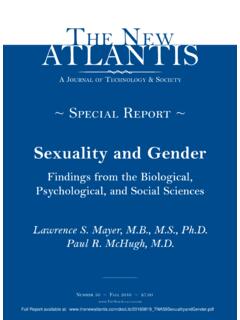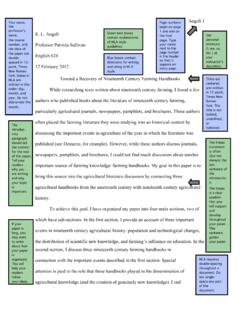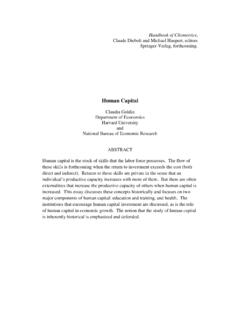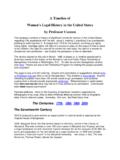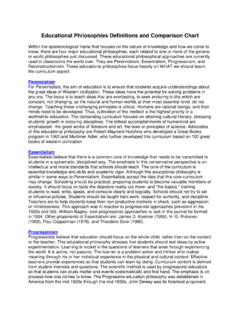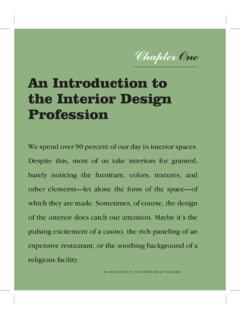Transcription of A Brief History of Education in America
1 A Brief History of Education in America Early American Education was primarily private or religious, and it brought mass schooling and literacy to the nation well before the public school system we know today was legislated into existence. Public schooling arose in response to an influx of immigrants who had different religions or cultures. Its primary focus was to establish social order and mainstream vast numbers of immigrant children into a common school setting. A mistrust of parents was common during the birth of public schools.
2 As an 1851 article in The Massachusetts Teacher reported: In too many instances the parents are unfit guardians of their own children the children must be gathered up and forced into school [C 79-80]. Over the past 150 years, mistrusting parents and forcing children into common schools has produced mixed results. Today, while some children receive a decent Education , many, particularly those in urban areas, receive a poor quality Education . In many instances, public schools have actually segregated the population more deeply between the have's and have-not's, creating a gulf of learning opportunities that is simply too wide for many parents to cross.
3 School choice bridges these gaps and returns Education to its American roots by empowering all parents, regardless of economic circumstances, with the freedom and opportunity to choose a better Education for their children. -- The ABCs of School Choice, Friedman Foundation, drawn from the work of Andrew Coulson, author of Market Education : The Unknown History Year(s) Stages of American Education Events in Education 1642 First Education law enacted by Massachusetts General Court requiring parents and guardians of children to PERMISSIVE ERA make certain that their charges could read and understand the principles of religion and the laws of the Commonwealth (O 147).
4 1749 During the stage, government permits Benjamin Franklin founds a private academy (a private secondary school) that offers a practical curriculum of a the organization of public variety of subjects and useful skills. By the mid 1800s, many such private academies exist, offering a wide array of schools subject to the approval curricula and courses ranging from traditional Latin and Greek to very practical, utilitarian studies (O 154). 1821 of local voters (O 159). First government-owned/operated public high school opens in Boston, MA (O 154).
5 Marked by complete parental authority 1826 Massachusetts passes a law requiring every town to choose a school committee, beginning the policy of ENCOURAGING ERA organizing public schools into a system under a single authority. Connecticut follows suit shortly thereafter (O. 159). 1827 During this stage, government explicitly Massachusetts enacts law requiring public high schools (O 180). 1830s encourages the establishment Seeking to win public support for government schools, chief advocate Horace Mann, who is appointed Secretary of of school districts and raising of Massachusetts Board of Education in 1837, assures Protestants that the public schools will regularly use the tax revenues to support them.
6 Protestant Bible (Coulson 81). 1836-1920 However, government did not More than 120 million copies of McGuffey's readers, which emphasize the ideals of literacy, hard work, diligence, require the establishment of and virtuous living, are sold (O 163). Mid-1800s schools (O 159). Despite a trend toward building government-run elementary schools, Maine and Vermont continue their practice of tuitioning' students ( , allowing districts that decided not to own/operate public schools to use public funds to Marked by parental authority; children pay costs of a district student's schooling at a private, parochial, or religious school of parents' choice).
7 1850 were not compelled to attend a US Census data reveal that only 1 in 10 people identified themselves as illiterate in the 1850 US census half a public school century before public school attendance became common (C 84). 1850 The Maine Supreme Court declares it legal for all students in the government schools to be compelled to read the Protestant Bible (C 82). 1851 Mistrust of parents spreads in Education leadership, as exemplified in this Massachusetts Teacher article: In too many instances the parents are unfit guardians of their own children the children must be gathered up and forced into school (C 79-80).
8 1855 COMPULSORY ERA More that 6,000 private academies (high schools for occupational and college prep) exist in the US, with an enrollment of 263,000 students (O 164). 1857 During this stage, government compels National Education Association (NEA) founded with 43 members (O 53). 1865-1900 the establishment of school Influence over children and Education shifts from parents to government authorities (C 82-83): districts, taxation for Throughout the second half of the nineteenth century , Education reformers, bureaucrats and teachers'.
9 Government schools, organizations pushed to increase their powers over children and public schools. curriculum and structure, and California State Superintendent of Public Instruction writes, The child should be taught to consider his children's school attendance (O instructor, in many respects, superior to the parent in point of authority [T]he vulgar impression that parents 160). have a legal right to dictate to teachers is entirely erroneous.. Wisconsin Teachers Association asserts that children are the property of the state.
10 1852- Marked by decline of parental authority; Compulsory school attendance laws are enacted in all states (C 84). 1913 children of certain ages compelled to 1900 attend school. (For a Brief period in A majority of children, ages 6 to 13, are now enrolled in government elementary schools. By 1980, 99% of some states, it was illegal for children to children attend government schools (O 164). 1909 attend non-government schools, even if First public junior high school established in Berkeley, California (O 181). 1916 parents could afford to pay tuition.)
